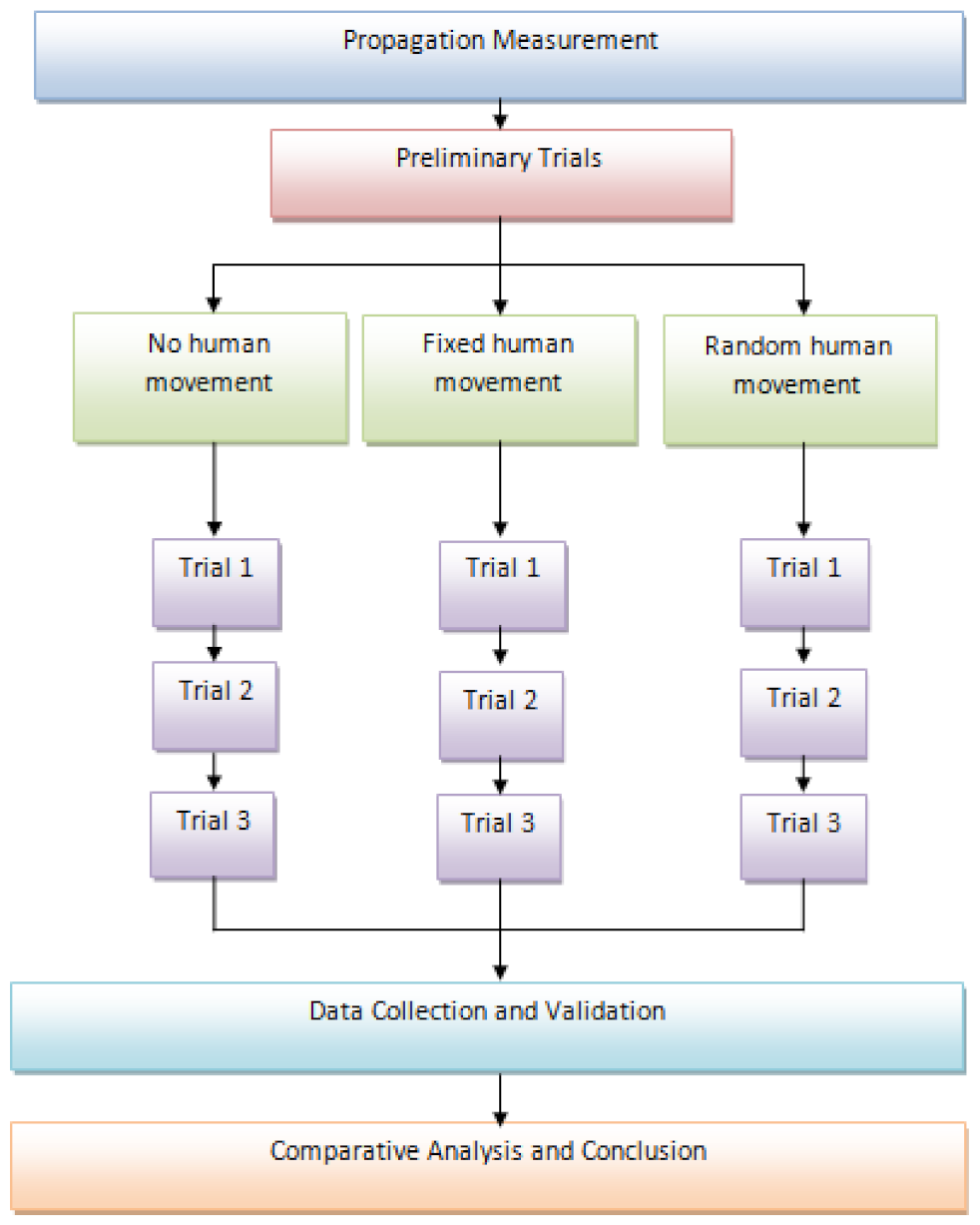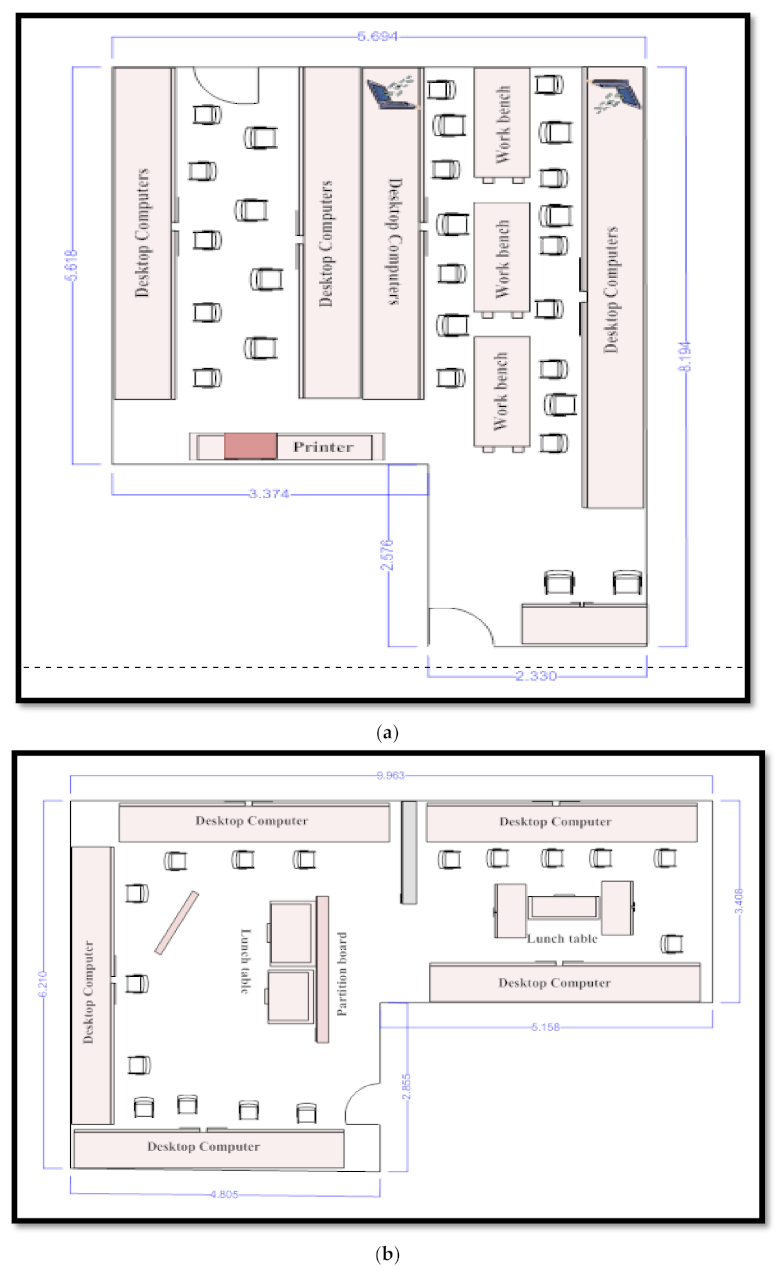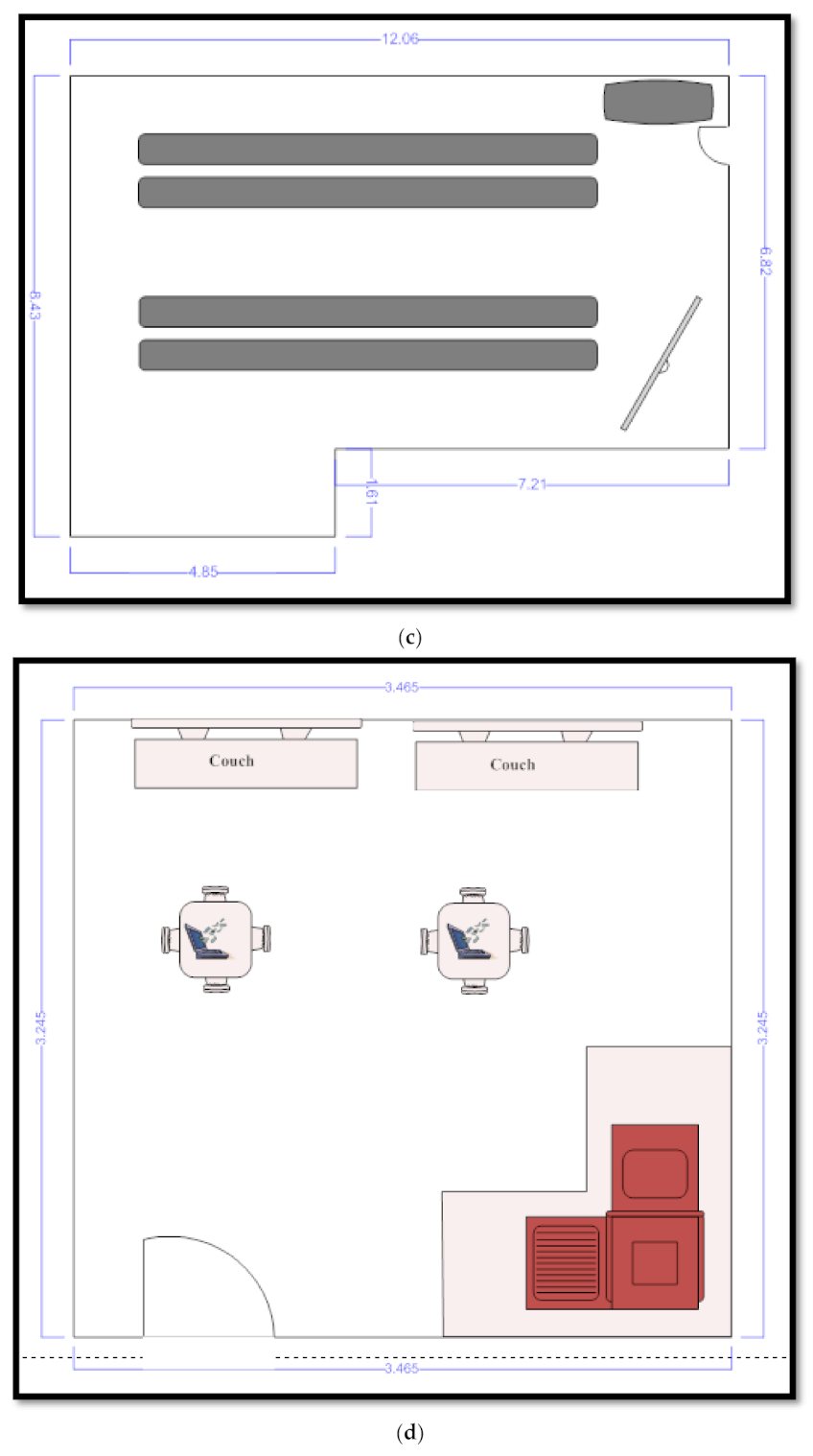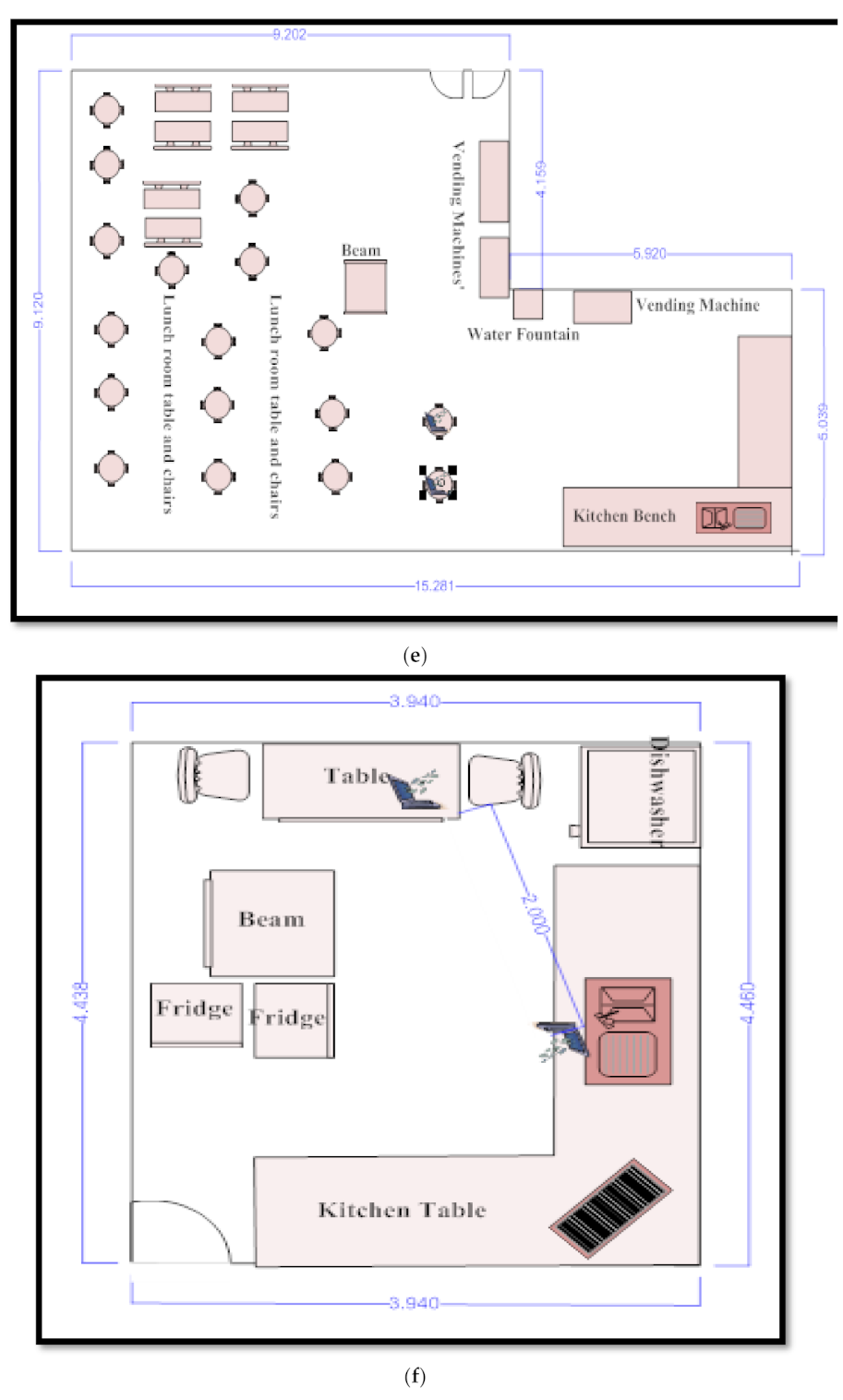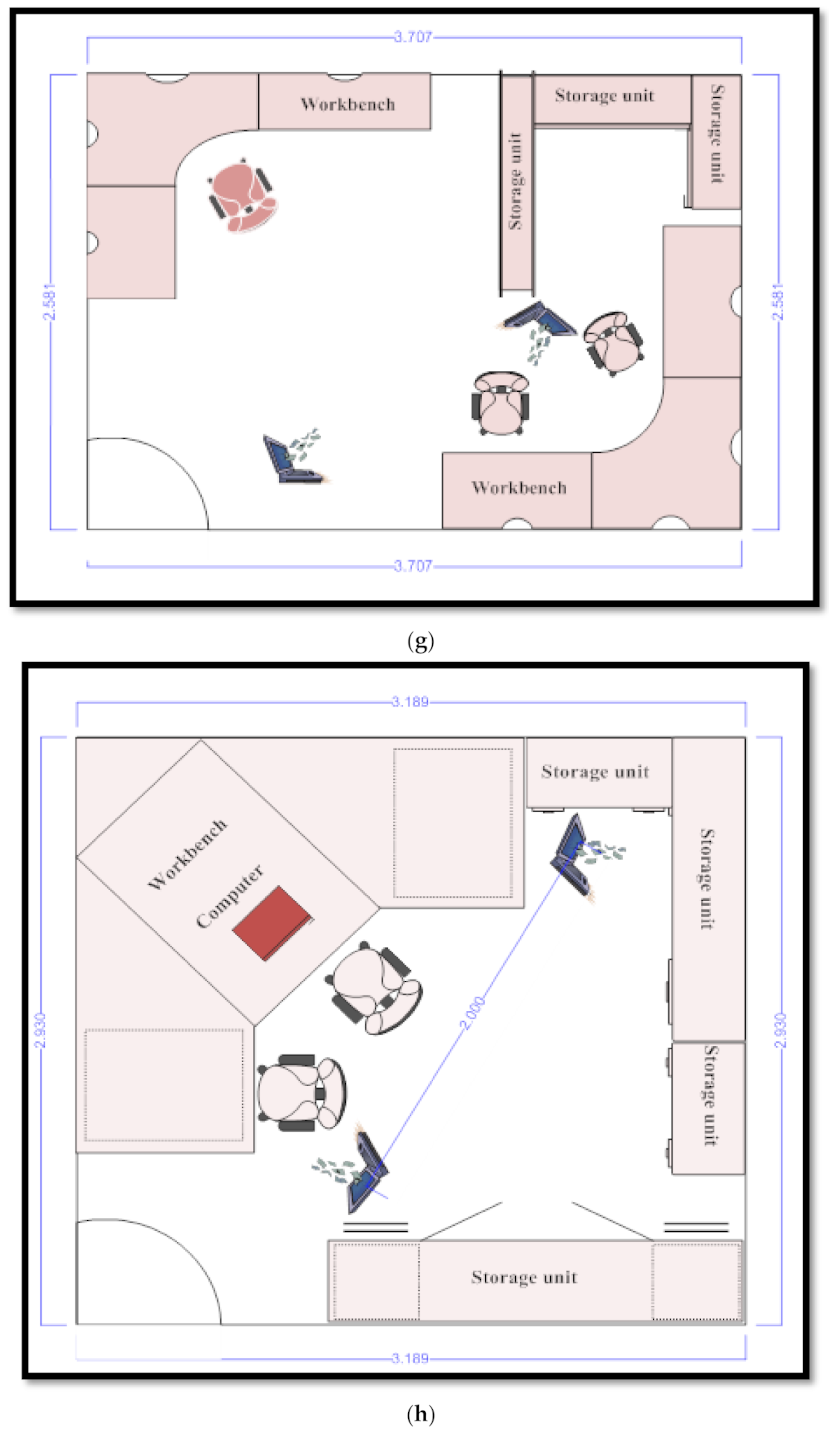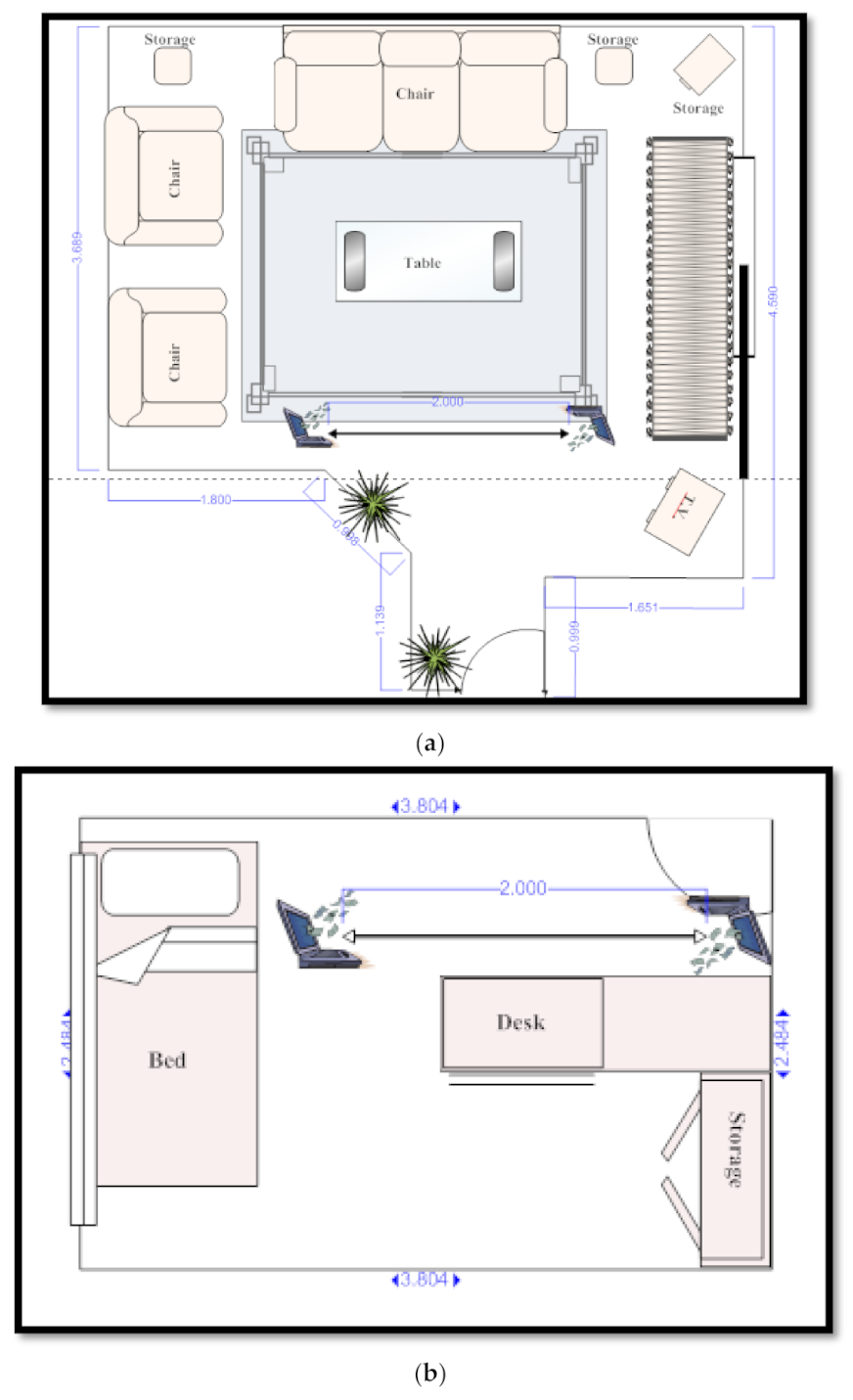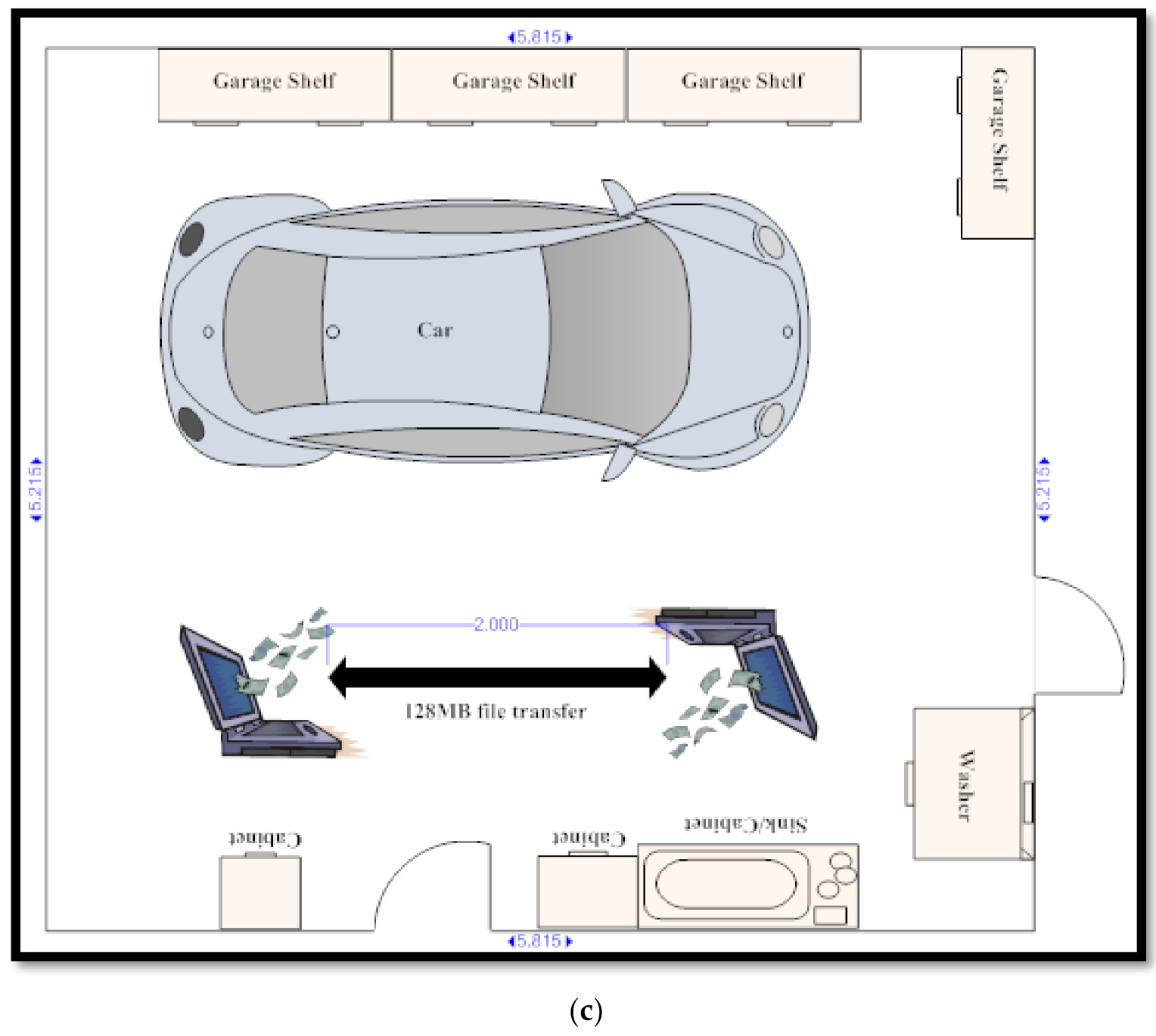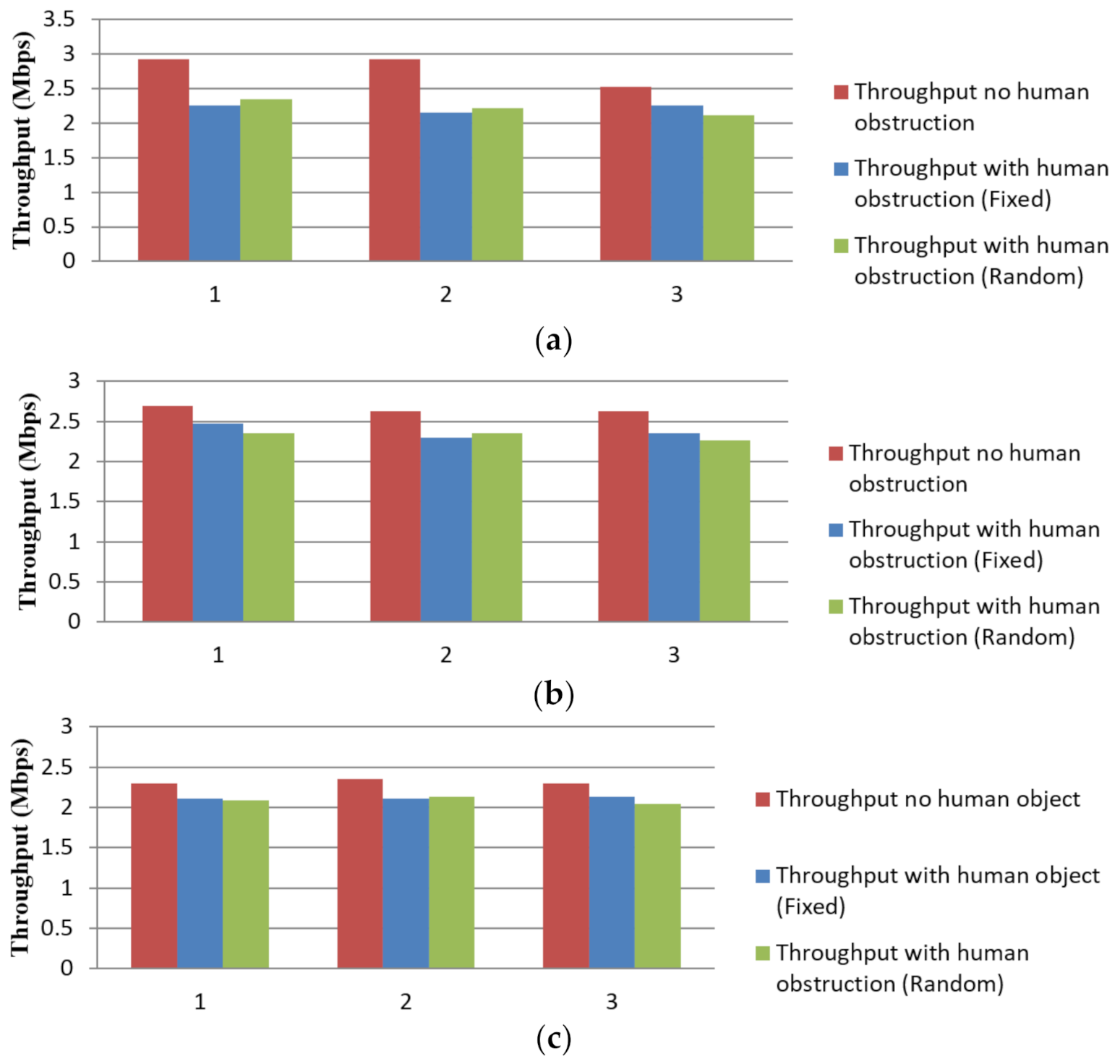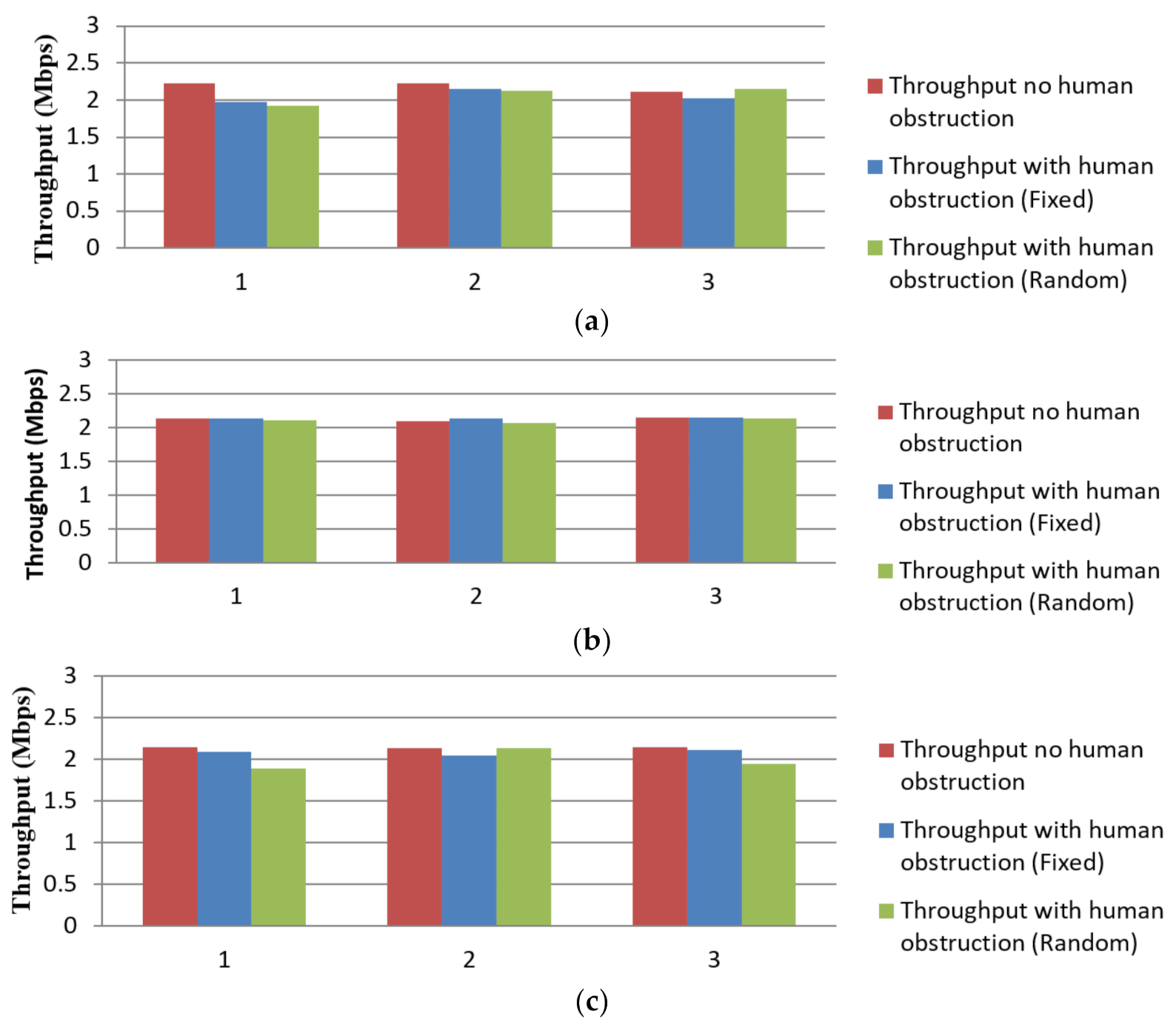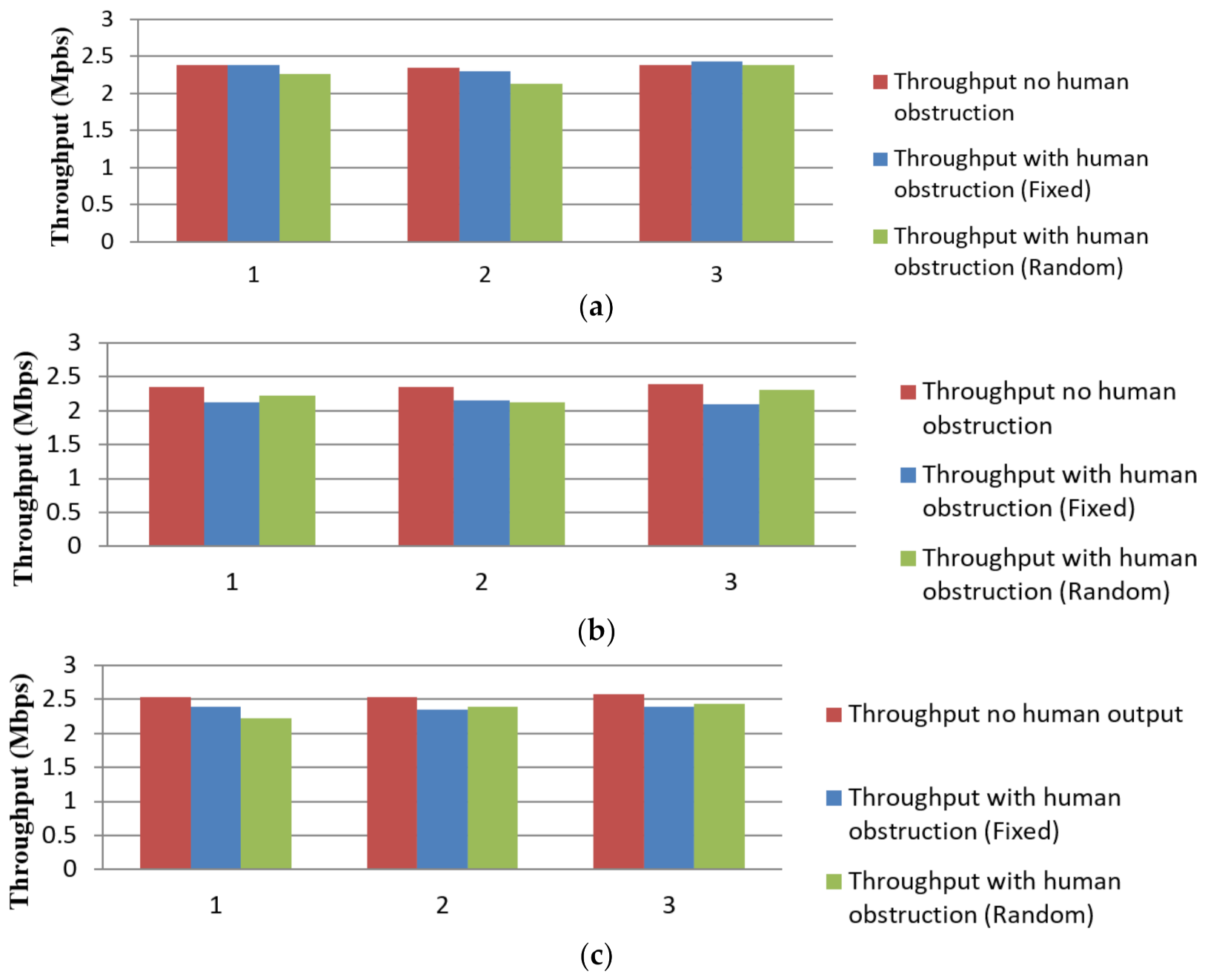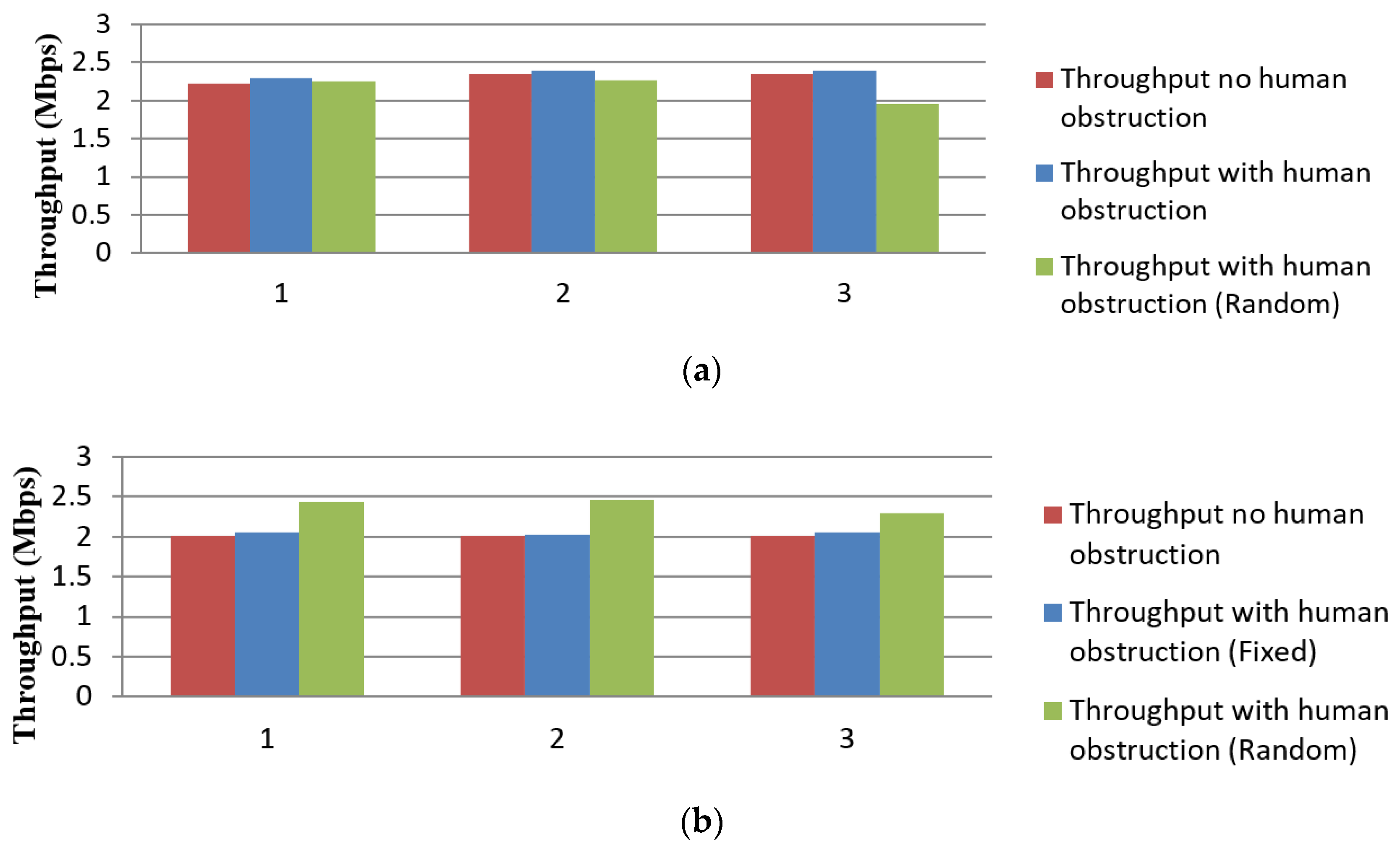1. Introduction
Recently, there has been a high demand for information over the Internet which has escalated the growth of Wi-Fi technology. Various research projects have been conducted to identify the performance of Wi-Fi networks in different environments, but the impact of people’s (human) movement on Wi-Fi link throughput has not been explored thoroughly.
The growth of IEEE 802.11 (“802.11”) wireless local area networks (WLANs), commonly known as Wi-Fi, was mainly due to the simplicity of setup, cost, and flexibility that is accessible by this technology. Wi-Fi technology can be quickly set up in places where physical wires are not feasible [
1]. These areas include, but are not limited to, schools, hospitals, airports, hotel lounges, carparks, cafes, libraries, etc. Wi-Fi technologies may be used to provide quick access to database information, to share files over a wireless medium, and in ad hoc office environments, etc. Schools can also benefit from this technology as it facilitates e-learning and increases revenue and scalability for multiple users in different locations, thus increasing the area size of the wireless network for more users to access data [
2]. There is no requirement where you need to use school computers to do homework as users can roam around in various locations, using mobile devices to access information through a wireless network.
As Wi-Fi is one of the most popular technologies for information gathering through the World Wide Web (WWW), the number of technological resources has become more demanding due to high-end applications (i.e., video streaming), where the capacity of Wi-Fi has become an issue. The Institute of Electrical and Electronics Engineers (IEEE) committee has standardized 802.11-based Wi-Fi for users requiring various network performances. Standards provided by IEEE are 802.11 a (released in 1999), 802.11 b (released in 1999), 802.11 g (released in 2003), 802.11 n (released in 2009), 802.11 ac (released in 2013), and the new 802.11 ax (released in 2019). These standardized 802.11 network protocols are used depending on the environment in which the Wi-Fi networks are being deployed. A basic example can be justified as if you are in a large organization with heavy users accessing the Wi-Fi network and the area of the building is very large, then using 802.11 n may be feasible because of high data stream rates and because it has large signal coverage. Currently, 802.11 n is the common protocol deployed in many residential homes and small offices.
Wireless networks have provided us with great advantages, i.e., quick wire-free setups; however, they lack in performance when data are being transmitted through an obstructed environment. Signal strength can substantially decrease as radio waves can refract various objects in a propagated environment. Performance issues can be encountered with the interference of radio waves occurring in a dense environment; this may cause packet dropping and delays.
To overcome wireless network performance issues and ensure the network is obtaining its best throughput, researchers have developed various techniques to overcome potential hurdles before deploying the technology. These techniques which are currently being used are: (1) computer simulation (e.g., Ns−3, OMNET + +), (2) radio propagation measurements, and (3) analytical modeling. Computer simulation is an easy and economical way of designing mock-up versions of a network without the need for expensive hardware. However, it still lacks some important factors from the real-life scenarios, e.g., human interferences, and the simulators are unable to record the accurate throughput due to the randomness of people’s movement and propagation interferences. Using propagation measurements provides a great way of finding the relationship between signal strength and Wi-Fi link throughput due to many factors that influence performance in various environments.
The deployment of a wireless network can be a bit tricky. If Wi-Fi routers are not cautiously placed, it may result in slowed down throughput rates and decreased signal strength. Therefore, careful consideration of access points must be addressed to optimize network performance. Testing the 802.11 technologies in different areas in a heavily obstructed environment can provide a better understanding of where access points (APs) are best placed for better performance. The wireless network deployment may turn out to be very expensive (in terms of time and cost) if proper testing has not been conducted.
In this paper, we study the effect of people’s (human) movement on Wi-Fi link throughput using propagation measurements in real environments, such as a suburban residential house, laboratory, library, lunchroom, and office room. Using different scenarios (no human, fixed human, and random human movement) in a real environment provides a comparative analysis to identify if there is any significant difference in Wi-Fi throughput performance. The advantage of this measurement approach is that the influence of radio propagation is included implicitly, and therefore it provides an unbiased representation of the environment and facilitates trustworthy performance estimation.
The contributions of this study are summarized as follows.
The main contribution and strength of this paper is the emphasis that practical field trial measurements using real hardware and software are crucial in developing a good understanding of Wi-Fi performance as they provide an unbiased representation of the environment in which the system operates. The most innovative aspect of this paper is the development of three practical scenarios and some measurement case studies of multistory buildings and a residential home environment that provide practical implications for system design and deployment.
We perform an extensive propagation measurement campaign for in-building Wi-Fi performance study covering the ground floor and floors 2 to 5 in a multistory building at Auckland University of Technology (AUT). In a suburban residential home, the recordings of the experiments were performed in three different rooms (bedroom, lounge, and garage).
We analyze and validate the system performance by conducting about 33 experiments and 99 field trials in various environments, including an obstructed office block, lunchroom, laboratory, library, and suburban residential home.
This paper is organized as follows.
Section 2 reviews related work on Wi-Fi performance. In
Section 3, we describe our proposed research design and methodology used in the study. Experiment details are discussed in
Section 4, and a discussion of the results is presented in
Section 5.
Section 6 concludes the paper.
4. Experimental Design
For experimenting with this research, we have selected a pair of laptops to form an ad hoc network, which has been placed majorly in four different propagation environments to generate different experiment scenarios, namely, obstructed office block, laboratory, library, and suburban residential home environments.
To identify if the two laptops are receiving good coverage, signal strength is measured in decibel-milliwatt (dBm) by using a software called inSSIDer, and it is referenced to electrical power unit in decibel (dB)—the typical range of wireless signal power in 802.11 generally operates between −70 dBm and −90 dBm.
Table 3 lists the hardware specifications and software used for setting up the experiments.
To measure the throughput, a file is transferred and a stopwatch is used to measure the file transmission time when data are sent across from sender (TX) to receiver (TX). Wi-Fi throughput is calculated using the following formula.
Propagation measurements were conducted on the ground floor, second floor, third floor, fourth floor, and fifth floor in the WT building at Auckland University of Technology (AUT). In a suburban residential home, the recordings of the experiments were performed in three different rooms, which are a bedroom, lounge, and garage room. The floor plans and images for each room with a description of the propagation environment are shown in
Figure 2 and
Figure 3, respectively.
Room WT402 laboratory (
Figure 2a) was the simplest room, consisting of a laser printer, several desktop computers, chairs and wooden tables to study on. Inside the lab room there were two exit doors, each located on both ends of the room. The two laptops were placed near the back end of the room, which showed higher signal coverage.
WT406 laboratory (
Figure 2b) consisted of partition walls in order to separate and privatize some sections of the room. There was a large quantity of Windows based desktop computers, which were placed along each side of the room. In the middle there was a wooden bookshelf, and by the entrance door there were two rubbish bins. In the environment of WT406 laboratory room, we placed the laptops near the entrance door as this measured the highest average point for signal strength.
Room WT306 (
Figure 2c) consisted of numerous Apple Mac computers running down the middle of the room. A document scanner and a laser printer were sitting on a table near the entrance door. The room is made up of concrete and the ceiling is made of perforated particle boards for ventilation; however, the window is made of translucent glass. The area size of the room was at an average of 12.64 × 6.09, where objects also placed in the room were two fixed white boards and a mobile white board. On the ceiling of WT306 there was a projector for group discussions and presentation. The placement of the pair of laptops was near the back end of the lab where the signal strength was strong.
WT014 lunchroom (
Figure 2d) was located on the ground floor of the WT building. The room consisted of kitchen utensils, a microwave, and wooden tables and chairs to sit and eat lunch on. The laptop placement was located near the entrance door, which showed overall good signal strength. WT523 lunchroom (
Figure 2e) was the largest of the three environments the experiments were conducted in; however, the room consisted of a large number of seating chairs and tables for students to have lunch on, vending machines located next to the entrance door for students to have quick snacks, and one water fountain located opposite the kitchen sink. Additionally, in the room was a microwave, a kitchen bench, a storage unit for kitchen utilities and a kettle. The pair of laptops was located near the kitchen sink located at the back end near the room window—this section had showed good signal strength and no loss in connectivity. Room WT401 (
Figure 2f) was the smallest lunchroom out of the three rooms the experiment was conducted in. The area size of the room is 3.35 m × 4.42 m, where the room consisted of a microwave, two fridges, an electric kettle and a wooden table for having lunch on.
Office room WT211 (
Figure 2g) had a slightly large open area space during experimentation. A couple of desktop computers, wooden bookshelves, and wooden storage units were placed in the room for the lecture needs, and a large number of books and lecture notes were also in the room during experimental study. The room was made up of plaster boards, a concrete exterior, particle boards and translucent glass for the window. Laptop placement was located near the back end of the second computer, where this produced good signal strength. WT210 (
Figure 2h) office room was full of paperwork, textbooks and electronic equipment—the room was full of clutter, which only enabled us to perform the experiment in the center of the room. However, when placing the pair of laptops in the center of the room, this still showed good signal strength for data to be sent and received.
In the lounge environment, propagation measurement is made to see all obstruction objects that can impact the radio signal when data are being transferred between a pair of nodes. The lounge is not a pure rectangular room, where the distance in meters is provided by the above image. There are no objects obstructing between the two laptops, as seen in
Figure 3a. In the bedroom environment (
Figure 3b), the room is a rectangular shape, where the area size is 3.804 m × 2.484 m (smallest room conducted in the suburban residential home). In the room, there are several objects where radio signals can bounce when transmitting data over the network, and the objects consist of a fabricated single bed, a wooden desk made of timber and a wooden storage unit. There were many objects in the garage environment (
Figure 3c) which can cause a slight degradation in signal strength due to the large clutter of objects. The area size of the room is 5.215 m × 5.815 m, where there was a car placed on one side of the garage.
4.1. Measurement Scenarios
The field trial measurements are conducted for four controlled stages. The stages consist of (1) preliminary measurement; (2) trial 1; (3) trial 2; and (4) trial 3, where each trial consists of no human, fixed human, and random human movement between a pair of nodes.
4.1.1. Preliminary Propagation Measurement
Preliminary trials are conducted in the first stage. The primary purpose of the preliminary measurement is to make sure that there is successful communication between the sender (TX) and receiver (RX), and in this stage, we also ensure that there are no packet drops. The ping command “ping –t < ip address > ” (Windows Command Prompt Graphical User Interface (GUI) using Windows 7 OS) is used on both nodes to address any packet transmission errors. This preliminary test was conducted for two minutes to ensure packets were not dropping during transmission before conducting any further experiments. Additionally, the measurement for best signal strength was used in the experiments by software insider, which confirmed the placement of the pair of laptops in an area with good signal strength.
Once preliminary tests were successfully completed, we moved to stage 2 to measure Wi-Fi performance throughput—in stage 2 there is no human movement between a pair of laptops.
Scenario 1—No Human Obstruction
Scenario 1 (stage 2) consists of no human movement between the pair of nodes. The experiments are conducted in a controlled environment where there is no interference from any objects between the sender and receiver when data are being transmitted. The data collated provide a solid base for analysis and comparison with other scenarios that will be used in the case study.
Scenario 2—Fixed Human Obstruction
Scenario 2 (stage 3) is based on fixed human movement between the pair of nodes. In this experiment, two humans are used in the test trials; both humans are positioned to face towards one another as the start point. As the transmission begins, both humans will be walking towards each other, ending up on the opposite side, and once they reach the opposite side the humans will walk back to their original position from the start of transmission, completing one cycle. The cycle continues until the data transmission is completed.
Scenario 3—Random Human Obstruction
Scenario 3 (stage 4) is very similar to scenario 2, where instead of having fixed human movement there will be random human movement between the pair of nodes. Random human movement is where objects (human) move in various directions in the area of the experimental environment. The random movement will be in between the pair of laptops when data are being transmitted from sender to receiver.
Figure 4 shows a logical view of all three scenarios.
4.2. Measurement Validation and Accuracy
The correct result interpretation depends on the knowledge of the measurement methods. The accuracy of the propagation measurement results was improved by addressing the following issues.
Co-channel interference: As the experiments were being conducted in the Auckland City (with a dense population), many Wi-Fi routers were being detected during the propagation measurements. To avoid co-channel interference on system performance, the access point (AP) was set to a different channel before experiments were conducted and remained the same to ensure result accuracy.
Validation: The propagation measurements were conducted three times per scenario to ensure the correctness of measurements and results [
5,
34]. The throughput was measured using a stopwatch, which was adopted by past research papers and used to calculate data transfer time between the pair of laptops.
People’s movement: The measurements were conducted after hours/weekends to ensure the consistency of human movement during the experiment. A constant of two humans was used to identify any significant impact on Wi-Fi throughput. Additionally, the distance between the two experimental laptops (Sender and Receiver) was kept at 1 m throughout the experimental trials to avoid the impact of distance of separation between Tx and Rx on system performance.
System configuration: To ensure there was no effect of system configuration on Wi-Fi performance, identical wireless adapters were used between the pair of laptops. Firewall and anti-virus were also disabled to ensure no packets were impacted by security settings.
5. Results and Discussions
In the investigation, we only focused on the impact of human movement on Wi-Fi link throughput performance by keeping all other variables/parameters constant, including the distance of separation between Sender (Tx) and Receiver (Rx), system configuration, Tx power, channel access protocols, the number of people in the experimental room, and co-channel interference. In fact, we kept a Tx–Rx separation of 1 meter for strong signal strengths throughout the field trial measurements. For instance, if we keep changing the distance (Tx–Rx separation), then it is hard to obtain unbiased Wi-Fi link throughput results (i.e., the distance will influence Wi-Fi performance on the top of people’s movement).
In the investigation, we consider a simple ad hoc network setting consisting of two nodes (Tx and Rx) with a distance separation of about 1 meter. This setting/configuration is appropriate for our experimental trials, ensuring that other factors are not influencing the results. A couple of people stand/move around in front of Tx to block the transmitted signal during the trials. We then observe the impact of human blockage on system performance. The question may arise about the impact of the number of people moving in the room. We performed field trial experiments with varying numbers of people, ranging from one to four, and found that the impact of the number of people moving on system performance is insignificant.
Another observation is that we consider two scenarios of people’s movement in front of Tx. One is fixed movement (just standing to block the Tx signal) and the other one is just random movement (no specific pattern and paths). This random movement is a more practical situation where people may be walking/passing by in the office block.
All the preliminary trials ran successfully except for the library environment, where experiments could not be conducted properly and where the ad hoc network faced a lot of interference due to many surrounding networks. This results in long delays in packet transmission, high packet losses and poor network connectivity.
5.1. Suburban Residential House
Lounge: Laptops are placed approximately two meters away from the door in the lounge. These are the points where the signal strength is high, as identified by the software. During the trials, there were no packet drops and network losses, which identified a good connection between the laptops.
Results collected from the experiments in the lounge environment showed that there is little impact on throughput when human movement is made between the pair of laptops. The average throughput rate where there was no human obstruction was 2.8 Mbps, and the received signal strength was at an average of −37 dBm (thus identifying strongly for a wireless network). Trial 3 showed throughput drops where there was no human obstruction, which could be due to the radio signal refracting of objects, causing a slight delay in transmission.
The average throughput for the fixed human movement was calculated at 2.22 Mbps compared to that of random human movement at an average of 2.15 Mbps. From the collected data, we identified that random human movement does cause slower throughput, which could be caused by the refraction or diffracting of radio waves against the human body, but this does not pose a great deal in network performance loss in a real-world scenario.
Overall, the data collected from the experiments in the lounge environment did show a drop in performance when there was human movement between a pair of nodes compared to no human movement, and this would be caused by radio waves being affected by diffraction, reflection, or absorption through the human body, but it did not cause a great impact on Wi-Fi throughput.
Bedroom: The impact of Wi-Fi throughput performance shows very little change in the performances in all three scenarios. The pair of laptops was placed between the bed and the entrance door due to the recorded signal strength.
By examining the collected data in
Figure 5b, it shows that the overall average throughput was in the range of 2.5 Mbps. The signal strength recorded from the software inSSIDer had a range between −36 dBm and −38 dBm, which identifies strong signal strength coverage, and due to the signal strength being very strong, there were no packet drops in transmission or network loss during all three scenarios.
Overall, considering that the performance showed very little significant impact when there was human obstruction, we see that random human movement still tends to cause slightly longer data transmission between a pair of nodes.
Garage: Wi-Fi link throughput showed near-identical throughput performances where data transfer rates between a pair of nodes averaged 2.3 Mbps.
Figure 5c shows the collected data output for all three trials.
Overall, by experimenting in the garage environment, there was no great change in Wi-Fi throughput, and we noticed that the throughput is slightly slower compared to the bedroom and lounge environments.
In each trial, we set up two experimental laptops with a separation of about 1 meter so that we could obtain a strong signal strength during experimental trials. By keeping a Tx–Rx distance of 1 meter, we avoided the impact of distance on system performance.
For the case of a fixed human scenario (Scenario 2), a couple of people stand at the middle position of the two laptops (about 0.5 m away from Tx). For the case of random human movement (Scenario 3), two people walk back and forth at the middle position of the two laptops. We observe that the impact of people’s movement on Wi-Fi link throughput performance is minimal.
In summary, we conducted three trials, which resulted in similar Wi-Fi throughput and had an overall average throughput rate of 2.09 Mbps. There was no significant impact on performance when comparing no human, fixed and random human movement, but what was noticeable is that when there was random human movement standing next to the omni-directional wireless adapter, the data being transmitted had a slight degradation in performance, which dropped to approximately 0.5 Mbps, and when the human moved out from the blockage of the antenna, the transmission speed went back to normal speeds. From this occurrence, we can identify that the radio waves have slightly absorbed or refracted off the human body, thus slowing speed at a small rate.
5.2. Laboratory Environment
WT402 Laboratory: Room WT402 consisted of Wi-Fi throughput results which are very close and had very little impact on the overall performance.
Figure 6a illustrates the result of WT402 collected data.
Running experiments in the WT402 laboratory showed a close throughput result in all trials conducted. The placement of the pair of laptops where located near the back wall as the software inSSIDer showed the highest average point in signal strength. When roaming around with the laptops to identify the best position to place the pair of laptops showed an average of −64 dBm to −76 dBm signal.
Figure 6a shows all three trials that have been conducted consist of similar Wi-Fi throughput and had an overall average throughput rate of 2.09 Mbps. There was no significant impact in performance when comparing no human, fixed and random human movement, but what was noticeable is when there is random human movement standing next to the omnidirectional wireless adapter, the data being transmitted had a slight degradation in performance which dropped to an approximately 5 Mbps, and when the human moved out from the blockage of the antenna the transmission speed went back to normal speeds. From this occurrence, we can identify that the radio waves have slightly absorbed or refracted from the human body, this slowing speed at a small rate.
WT406 Laboratory: Experiments conducted in room WT406 laboratory showed a small variation in throughput performance, which produced little difference in Wi-Fi throughput. An interesting finding that one can observe in
Figure 6b is that random human movement had the highest throughput performance.
Overall, the results show a large variation in performance as there might be a possibility that experiments conducted in a laboratory may vastly differ in throughput.
WT306 Laboratory: The data collected when experimenting in the laboratory showed results that consisted of a slight significant impact.
Figure 6c illustrates the variation in performance, where fixed human movement showed the lowest rate of throughput. The recorded signal strength was at an average of −65 dBm to −74 dBm, which produced a good connection. Even though the results conducted showed variation in performance for one scenario, the signal strength remained strong, with no network loss during transmission and packet losses.
Overall, one can observe the performance of Wi-Fi throughput as averagely good, where only one scenario showed a very bad data transfer rate, which could be due to external radio interference.
5.3. Lunchroom
WT014 Lunchroom: The experiment conducted in room WT014 is located on the bottom floor near the faculty of Design and Creative Technology, where we saw little impact on Wi-Fi throughput in all three scenarios.
The signal strength was slightly different compared to the laboratory environment, even though all the rooms are located in the same building. The RSSI averaged between −60 dBm and −65 dBm and we did not see any drop in packets or network connectivity.
From the data collected, the highest average throughput recorded was where there was no human obstruction and random human movement at an average of 2.38 Mbps. The performance was very much the same, where human movement did not cause a great deal of significant impact. Comparing results with no human and random human movement, we see that fixed human movement had an average of 2.37 Mbps, which showed little change but not enough to make a differential conclusion. Even though there was human interference, it seems to pose no significant contribution to the outcome, where the difference in both scenarios is 0.01 Mbps. Overall, we observe that there is no significant outcome using Wi-Fi link throughput.
WT523 Lunchroom was the largest room compared to all three rooms where the experiments have been conducted. Before running the experiments during the preliminary trials, we noticed that in some areas there was bad connectivity when trying to set up the ad hoc network—this resulted in black spots, packet loss, and long delays, causing time-outs to occur. When placing the pair of laptops near the kitchen bench, we noticed a strong connection with no packet loss and high throughput time.
Figure 7 illustrates no human interference where this is the benchmark for throughput performance to see if there is a great deal of significant impact. The scenario with no human obstruction had an average throughput result of 2.37 Mbps. The signal strength was strong where there were no packet delay and packet loss during the transmission of data. The average RSSI recorded was constant at −76 dBm when conducting experiments in the WT523 lunchroom.
By investigating both fixed and random human movement scenarios, we have identified that the average performance showed higher throughput with random human movement at 2.22 Mbps compared to fixed human obstruction at 2.12 Mbps. As the performance difference between the two scenarios is 0.10 Mbps, it did not pose a great deal of significant impact on the overall data transfer rate. Considering the room was the largest out of all the lunchrooms, the experiments produced a good throughput rate, which was interesting as we thought it would take a considerable amount of time for radio waves to receive a signal from the sender node due to the large area coverage.
Another interesting factor is the internal radiofrequency such as microwave, where it did not cause a great deal of impact on the data transfer rate between the pair of nodes. Overall, from the data collected there was no great deal of significant impact on Wi-Fi throughput performance, where random and fixed human movement showed a very close result in a larger room.
WT401 Lunchroom was the smallest room for experiments conducted in all experimental environments where the results are shown in
Figure 7, illustrating that Wi-Fi throughput performance is very close. The benchmark (no human movement) throughput consisted of an average of 2.55 Mbps.
When experimenting in WT401 lunchroom, the signal strength was strong and we noticed that during data transmission between the pair of nodes there was no time out when packets were being sent. The average signal strength recorded was between −64 and −76 dBm. Comparing the performance between fixed and random human movement, there was very little difference. Fixed human obstruction showed a throughput rate of 2.38 Mbps compared to random human movement at 2.35 Mbps. Considering this, showing a higher throughput rate compared to the other room could be since this room is the smallest and is very dense, causing radio waves to reflect off walls slightly faster than in a larger room.
Overall, the results show very little impact when there is fixed and random human movement, which shows that in a real-world environment the impact of people’s movement does not pose a great change in network performance.
5.4. Office Environment
WT211 Office room was the smaller room out of the office block environment, and this room consisted of a lot of clutter with a vast number of textbooks, shelves for book storage, and technological equipment. From the data collected during the experiment, we produced an illustration to identify if there is a significant impact on performance.
Figure 8a shows the throughput performance difference in both scenarios.
There is very little impact on human interference when there is fixed and random human movement. The average data transfer rate for no human obstruction is 2.31 Mbps, where when there are fixed human obstructions for the first time out of all scenarios the throughput is higher at 2.36 Mbps. Even though the performance difference is very small, there could be some attributes that could have affected the transfer rate to be slightly faster. Factors that could have contributed to a slight increase in throughput could be due to the omnidirectional antenna, where the radio waves bouncing off some objects traveled slightly faster for the receiver to receive the data.
The random human movement showed an overall throughput of 2.16 Mbps, which is slower than both scenarios (fixed and random human movement), which was to be expected. The last trial had a slight drop in performance as a human object remained near the omnidirectional antenna, which reduced the speed of data transmission.
Overall, the results show an interesting result as we see for the first time when there is a human obstruction that the throughput is slightly higher than no human movement, but it does not pose a great deal of impact in a real-life Wi-Fi network environment.
WT210 Office room showed an outcome where random human movement consisted of higher throughput compared to no human and fixed human movement (where they both had near the same throughput).
Figure 8b shows a graphical representation of the data collected when the experiments were conducted.
When the experiments were conducted, the received signal strength was good at an average of −70 dBm to −78 dBm. There were no losses in packet transmission when data were sent from one node to another, which provided strong network coverage.
The average throughput result for no human obstruction was 2.01 Mbps, and fixed human interference consisted of a throughput of 2.04 Mbps, which is slightly slower but did not create a large difference in performance. When there was random human movement there was an increase in throughput rate, which resulted in an average of 2.39 Mbps. This increase in performance could be due to radio waves refracting from a random human movement, which could have possibly resulted in a faster data transfer rate.
Overall, the performance showed an interesting result where random human movement showed higher throughput performance compared to fixed and no human movement, but again, this provided no significant impact in a real-life environment.
5.5. Cross Comparison and Discussion
To evaluate the overall impact of human movement on Wi-Fi link throughput performance, cross-comparison is used to analyze any significant performance issues in such network scenarios.
Table 4 shows summary results for 11 selected scenarios under four radio propagation environments (Residential Home, Office Block, Lunchrooms, and Laboratories). The offices, lunchrooms, and laboratories are located in a multi-story building of Auckland University of Technology (AUT)’s WT tower building. Column 1 lists 11 selected scenarios (Lounge, Bedroom, and Garage in Residential Home; WT211 and WT210 are Offices; WT014, WT523 and WT401 are Lunchrooms; and WT306, WT402, and WT406 are Laboratories). Column 2 shows Wi-Fi throughput (measured in Mbps) without human obstruction, which is used as a reference point to compare results for fixed and random human movement. The link throughputs for fixed human obstruction and the corresponding throughput degradation are shown in Columns 3 and 4, respectively. Likewise, the link throughputs for random human obstruction and the corresponding throughput degradations are shown in Columns 5 and 6, respectively. The right most column (Column 7) shows the difference in the throughput degradation of fixed and random human obstruction.
The “throughput degradation” (measured in %) is defined as the ratio of the difference between the individual link throughput and the reference throughput to the reference throughput. It indicates the variation in link throughput with respect to the reference throughput.
By looking at the throughputs in the case of no human obstruction, we observe that the maximum throughput achieved is 2.8 Mbps in the lounge followed by the bedroom (2.65 Mbps). The throughputs for the remaining nine scenarios/environments (Garage, Offices WT211 and WT210, Lunchrooms WT014, WT523, and WT401, and Laboratories WT306, WT402, and WT406) are slightly lower than the throughputs obtained both in the lounge and bedroom. This is mainly due to the nature of the propagation environments where measurements were carried out. For example, in the garage there was a car and other metal objects including the garage door when measurements were taken, resulting in lower throughput than the lounge and bedroom. Similarly, freezers and microwaves in the lunchrooms, PCs and desks in the laboratories, and bookshelves containing books and other objects in the offices contributed to lower throughputs.
Let us focus on the effect of fixed human obstruction on system performance. Comparing the results in a residential home environment, the throughput degradation is 13.2% on average. In the case of the office environment, we found that the throughput degradation is 6.3%, which is slightly lower, but it resulted in no great deal of significant impact on system performance. However, the average throughput degradation for lunchroom and laboratory environments was found to be 5.9% and 3.2%, respectively. Although Wi-Fi link throughput slightly varies in different environments (offices, lunchrooms, and labs), overall, the impact of fixed human obstructions on system performance is not very significant.
We now consider the effect of random human obstruction on system performance. We observe that in a residential home environment, the throughput is slightly lower than no human obstruction in all rooms where the field trial measurements have been conducted. The throughput degradation (on average) for the residential home, offices, lunchrooms, and laboratories is 14.2%, 8.3%, 4.7%, and 4.9%, respectively. Even though the throughput degradation is small, we still see Wi-Fi throughput being affected due to human obstruction.
By looking at Column 7, one can observe that the difference in the throughput degradation of fixed and random human obstruction ranges from 1.3% to 2.3%, which is insignificant. Overall, several interesting points have been analyzed from the findings made through this research. This paper provides discussion and analyses from the data collected through extensive empirical study. The conclusion and future research directions are discussed next.
6. Concluding Remarks
The impact of people’s movement on Wi-Fi link throughput performance using radio propagation measurements was investigated. Field trial measurements, data collection, and analysis were carried out to make a meaningful conclusion. All empirical results were validated and tested for three different scenarios (no human, fixed, and random human movement). Preliminary measurements were conducted to find out whether data transmission between two nodes in a wireless environment is successful. Preliminary results show that in an ad hoc network, signal coverage in all measurements was good except for the AUT library, where transmission failed due to high interference within the coverage area.
Once the preliminary trials and measurements were completed, Wi-Fi link throughput performance was conducted in obstructed office block, laboratory, library, and suburban residential home environments. Our main findings are summarized below. (1) Random and fixed human movement do not pose a greatly significant difference in Wi-Fi throughput compared to no human movement in the environments where the experiments were conducted. In fact, the performance difference between fixed and random human movement is about ±0.07 Mbps on average, which is insignificant, and (2) in the AUT library environment, it can be difficult to obtain good Wi-Fi throughputs due to external radio interferences. These interferences are mainly caused by wireless devices sharing the same frequency and the surrounding materials the library is made of, which reduced signal strength and loss in network connectivity. The results reported in this paper provide some insights into the effect of people’s movement on Wi-Fi link throughput performance, which can help network engineers and planners to deploy wireless networks at residential homes, apartments and commercial buildings.
As we have investigated human movement’s effect on Wi-Fi link throughput using propagation measurements, the exploration of a similar study is still required as there are a considerable number of factors that can affect Wi-Fi throughput. An investigation of human movement’s effect on Wi-Fi link throughput at the 2.4 GHz and 5 GHz spectrum is suggested as future work.
